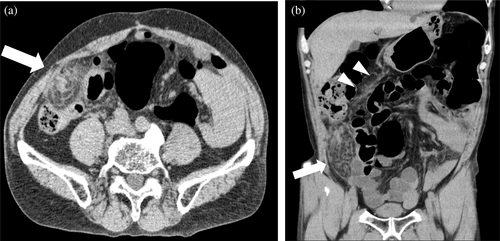Colectomy, especially right hemicolectomy, is a possible predisposing factor of omental torsion
Omental torsion is a condition in which the greater omentum twists to such an extent that blood flow is impeded. Although primary omental torsion is idiopathic, a long pedicle of the omentum, a bifid omentum, and other anatomic variations of the omentum were documented as predisposing factors.1 Secondary omental torsion always has at least one intra-abdominal pathology, one of which is an intra-abdominal adhesion by previous surgery.2 Until present, however, few articles have discussed the effect of the procedure in the previous abdominal surgery on the onset of omental torsion. In this report, we highlight the morphological changes of the greater omentum during previous colorectal surgery, possibly contributing to secondary omental torsion.
A 59-year-old male patient visited our emergency department with a complaint of exacerbating abdominal pain for 2 weeks. He underwent laparoscopic right hemicolectomy for ascending colon cancer of pathological stage IIIB 1 year before the current episode. Preoperative diagnosis of omental torsion was made by computed tomography (Fig. 1). There was no evidence of a recurrence of colon cancer. An open partial omentectomy was performed. The omentum was torsioned bipolarly, where a proximal pole arose from a residual omental fissure made by the previous surgery (Fig. 2a) and a distal pole was fibrously attached to the sigmoid colon (Fig. 2b). The illustration of the operative findings is shown in Figure 2c. He was discharged home on postoperative day 9 without any postoperative complication.


Right hemicolectomy involves the dissection and the detachment of the omentum from the transverse colon for mobilization or anastomosis, which may result in the elongation and the higher mobility of the omentum. Moreover, an omental fissure could be created during the manoeuvres. The same condition, in a mirror-reversed manner, can be seen in the left hemicolectomy. The morphological changes of the omentum during colectomy can facilitate omental torsion synergistically with intra-abdominal adhesions.
The right side of the omentum is described to be more mobile, longer, and heavier3; thus, right hemicolectomy seems to be more susceptible to omental torsion than other types of colectomies. We searched Pubmed until present using the terms, ‘omental torsion’, ‘omental infarction’, ‘colon’ and ‘colorectal’. We found 79 articles in English, among which three articles described 11 symptomatic patients with secondary omental torsion that may be related to previous colorectal surgery.4-6 Eight patients among the 12 patients, including the current case, underwent right hemicolectomy, which was in line with our hypothesis.
Colectomy with the manipulation to the omentum, especially right hemicolectomy, might be a possible predisposing factor for omental torsion.
Author Contributions
Koichi Komatsu: Conceptualization; writing – original draft. Hiroaki Nozawa: Conceptualization; supervision; writing – original draft; writing – review and editing. Hirofumi Sonoda: Writing – review and editing. Shinya Abe: Writing – review and editing. Shigenobu Emoto: Writing – review and editing. Koji Murono: Writing – review and editing. Kazuhito Sasaki: Writing – review and editing. Soichiro Ishihara: Conceptualization; supervision; writing – review and editing.




